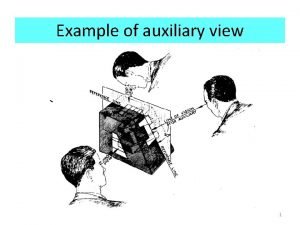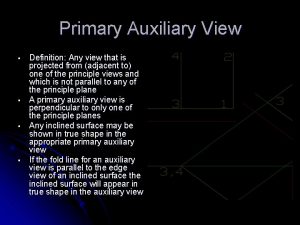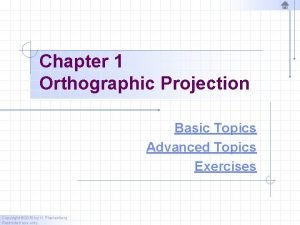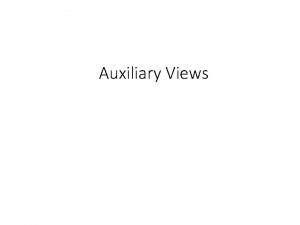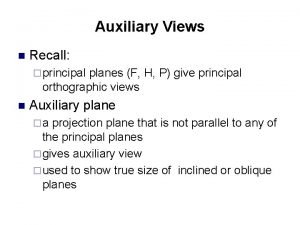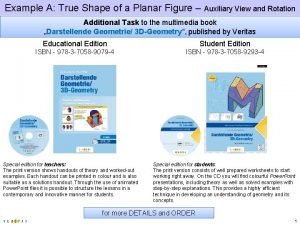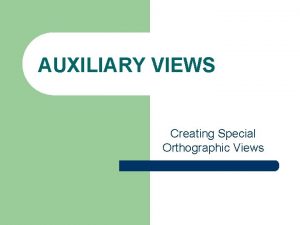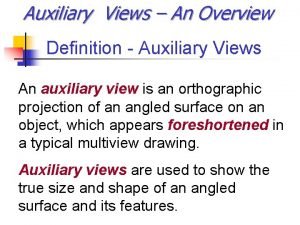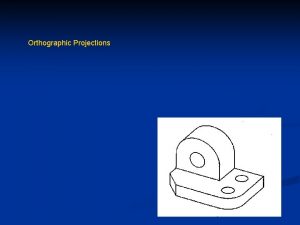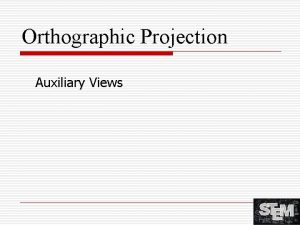Example of auxiliary view 1 Projections including auxiliary












- Slides: 12

Example of auxiliary view 1

Projections including auxiliary view 2

Primary auxiliary view (on a plane perpendicular to one of the principle planes) TV AUXILIARY PLANE P TO FRONT Fold line, Reference axis PRIMARY AUXILIARY VIEW FV SV Exact dimensions and shape can be seen without any calculations Plane is rotated about the line of intersection Q. Auxiliary plane is perpendicular to which principal plane and at an angle (other than 3 90 o) to which principal plane ?

AUXILIARY VERTICAL PLANE (AVP)- (perpendicular to HP, at an angle to VP) Auxiliary Front View Auxiliary Vertical Plane a 1’ AVP a’ A VP a’o = a 1’o 1 y a o 1 a 1’ y 1 x x 1 o o 1 a a HP Procedure for drawing auxiliary view • Draw aa 1’ perpendicular to x 1 y 1 such that a 1’o 1 = a’o a HP y 1 • Draw x 1 y 1 at an angle a to xy y P x o a’ AV x 1 VP 4

AUXILIARY INCLINED PLANE (AIP)- perpendicular to VP and inclined to HP Auxiliary Top View a 1 o 1 y 1 a’ a 1’ VP o 90 O VP a’ AIP A x 1 = ao x b x 1 y 1 o 1 b y o a 1’ a AI P a HP HP Procedure for projecting A on AIP: • Draw front and top view a’ and a respectively Auxiliary Top View • Draw x 1 y 1 such that it makes an angle b with xy • Project a 1’ on AIP by drawing a line a’a 1’ such that a’a 1’ is perpendicular to x 1 y 1 and a 1’o 1 = ao 5

PROJECTIONS OF PT. A Lines with same color have the same length P TO o When 2 planes are perpendicular to the same third plane the distances of the projection of a point from the reference line (junction line) of 1 st. 2 planes is the same TV a FRONT A a’ a 1 o 1 AU AIP a’ Y R A I L I X A line drawn parallel to the edges will join the two projected points a’ and a 1 o FV o 1 a Distances Aa (point to front view)= a’o (in top view which is perpendicular to front view)= a 1’o 1 (in auxiliary view, which is also perpendicular to front view) 6

Draw the auxiliary view of a plane ABC on a plane which is perpendicular to the frontal plane and inclined at an angle of 45 o to the top plane. Draw another auxiliary view on a plane which is perpendicular to the top plane and inclined at an angle 60 o to the frontal plane. Given A(50, 10, 30), B(10, 40, 0), C(10, 30, 50) USE III rd ANGLE Distance of a 1 from x 1 y 1 = distance of a from OZ x 2 X 50 40 30 20 10 O 10 20 30 40 50 Y T a 1’ a c b 10 20 Distance of b 1 from x 1 y 1 = distance of b from OZ a’ 50 b 1’ 45 o y 2 Distance of a 1’ from x 2 y 2 = distance of a’ from OZ Distance of b 1’ from x 2 y 2 = distance of b’ from OZ c 1’ 60 o Distance of c 1 from x 1 y 1 = distance of c from OZ Distance of c 1’ from x 2 y 2 = distance of c’ from OZ Z y 1 c’c 1 b’ F x 1 b 1 a 1 7

Projection of a cuboid on 2 auxiliary planes Fold line TV y 2 e’, h’ x FV a’, d’ h 1 e 1 f 1 a 1 b 1 Viewing direction f’, g’ b’, c’ a x 2 y 1 b a, e d, h b, f a 2 c, g y From these views, the auxiliary views are drawn on 2 planes: i) Perpendicular to the top plane and at an angle a to the frontal plane, ii) perpendicular to the frontal plane and at an angle b to the top plane X 2 y 2 is the junction line of plane Viewing direction perpendicular to the horizontal plane b 2 f 2 c 2 x 1 g 1 d 1 c 1 The figure shows the front view and top view of a cuboid e 2 d 2 h 2 g 2 and the horizontal plane, hence drawn in the top view X 1 y 1 is the junction line of the plane perpendicular to the front view and the front view, hence drawn in the front view 8

SECONDARY AUXILIARY VIEW q Required when the plane of view is oblique or not perpendicular to any of the principal planes. q First draw front and top views. q A primary auxiliary view is drawn first (which is perpendicular to one of the principal planes) with the view in a suitable direction. q A secondary auxiliary view is drawn on a plane that is perpendicular to the primary auxiliary view at an angle such that the appropriate view of the required feature is obtained.

a 2 Primary auxiliary view (PAV) a 1 d 2 b 1 d 1 c 2 o 2 c 1 Secondary auxiliary view (SAV) o 1 a o d 1 2 b T 1 c T F o’ Given Top and Front views of a square pyramid. Obtain a view of the pyramid with edge oc viewed as a point. -Axis for PAV is parallel to oc in the Top view. -Axis for SAV is perpendicular to c 1 o 1. -o 1 c 1 is the True Length. c 2 o 2 overlap in the secondary auxiliary view d’a’ c’b’

NOTE q. All outermost lines or curves of a view are visible (solid). q. Lines and curves joining the point closest to the axis in the previous view will be visible (solid) q. Rest of the lines and curves may or may not be hidden (drawn dashed)

Secondary auxiliary view of a cube PA plane at 45 o to Front and perpendicular to Top. SA plane is 60 o to Top and perpendicular to PAP Distances: Primary auxiliary view h 1 x 1 e 1, f 1, a 1, b 1 from x 1 y 1 = e, f, a, b from xy g 1, d 1 e’, h’ c 1 f 1, a 1 f’, g’ TV 45 o a’, d’ x a, e b’, c’ y x 2 b, f FV respectively Secondary auxiliary view e’, f’, a’, b’ from x 1 y 1 = e 2, f 2, a 2, b 2 from x 2 y 2 h’, g’, d’, c’ from x 1 y 1 = h 2, g 2, d 2, c 2 from x 2 y 2 b 1 y 2 60 o g 2 y 1 f 2 e 2 d, h h 1, g 1, d 1, c 1 from x 1 y 1 = h, g, d, c from xy b 2 respectively Direction of view is perpendicular to the fold line c 2 h 2 d 2 c, g a 2
 Auxillary plane
Auxillary plane Definition of auxiliary line
Definition of auxiliary line Auxiliary view
Auxiliary view Types of auxiliary views
Types of auxiliary views How to draw orthographic projection
How to draw orthographic projection Auxillary view
Auxillary view Auxiliary view
Auxiliary view The offset tool is useful in setting up an auxiliary view
The offset tool is useful in setting up an auxiliary view Auxiliary view
Auxiliary view The offset tool is useful in setting up an auxiliary view
The offset tool is useful in setting up an auxiliary view Drawing auxiliary view using center plane reference
Drawing auxiliary view using center plane reference Depth auxiliary view
Depth auxiliary view When is an auxiliary view needed
When is an auxiliary view needed
